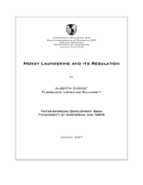Money Laundering and its Regulation
Date
Jan 2007
The recent wave of terrorist attacks has increased the attention paid to money laundering activities. Using several methodologies, this paper investigates empirically the determinants of money laundering and its regulation in over 80 countries by assembling a cross-country dataset on proxies for money laundering and the prevalence of feeding activities. The paper additionally constructs specific money laundering regulation indices based on available information on laws and their mechanisms of enforcement and measures their impact on money laundering proxies. The paper finds that tougher money laundering regulations, particularly those that criminalize feeding activities and improve disclosure, are linked to lower levels of money laundering across countries; the results are robust to potential endogeneity of money laundering regulation. The relevance of historical factors in explaining the variation of money laundering regulation across countries sheds light on theories of institutions and provides room for further action, particularly in the areas of the law that improve the impact of criminalization, including liability of intermediaries, reductions of the burden of proof and better disclosure.



